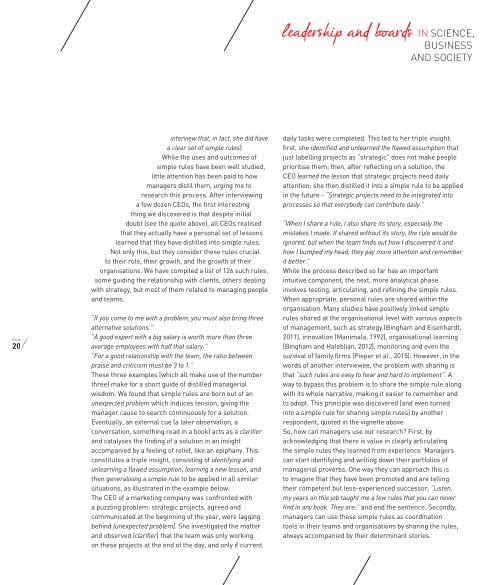Executives in Science, Business and Society 3
You also want an ePaper? Increase the reach of your titles
YUMPU automatically turns print PDFs into web optimized ePapers that Google loves.
leadership <strong>and</strong> boards IN SCIENCE,<br />
BUSINESS<br />
AND SOCIETY<br />
PAGE<br />
20<br />
<strong>in</strong>terview that, <strong>in</strong> fact, she did have<br />
a clear set of simple rules)<br />
While the uses <strong>and</strong> outcomes of<br />
simple rules have been well studied,<br />
little attention has been paid to how<br />
managers distil them, urg<strong>in</strong>g me to<br />
research this process. After <strong>in</strong>terview<strong>in</strong>g<br />
a few dozen CEOs, the first <strong>in</strong>terest<strong>in</strong>g<br />
th<strong>in</strong>g we discovered is that despite <strong>in</strong>itial<br />
doubt (see the quote above), all CEOs realised<br />
that they actually have a personal set of lessons<br />
learned that they have distilled <strong>in</strong>to simple rules.<br />
Not only this, but they consider these rules crucial<br />
to their role, their growth, <strong>and</strong> the growth of their<br />
organisations. We have compiled a list of 126 such rules,<br />
some guid<strong>in</strong>g the relationship with clients, others deal<strong>in</strong>g<br />
with strategy, but most of them related to manag<strong>in</strong>g people<br />
<strong>and</strong> teams.<br />
“If you come to me with a problem, you must also br<strong>in</strong>g three<br />
alternative solutions.”<br />
”A good expert with a big salary is worth more than three<br />
average employees with half that salary.”<br />
“For a good relationship with the team, the ratio between<br />
praise <strong>and</strong> criticism must be 3 to 1.”<br />
These three examples (which all make use of the number<br />
three) make for a short guide of distilled managerial<br />
wisdom. We found that simple rules are born out of an<br />
unexpected problem which <strong>in</strong>duces tension, giv<strong>in</strong>g the<br />
manager cause to search cont<strong>in</strong>uously for a solution.<br />
Eventually, an external cue (a later observation, a<br />
conversation, someth<strong>in</strong>g read <strong>in</strong> a book) acts as a clarifier<br />
<strong>and</strong> catalyses the f<strong>in</strong>d<strong>in</strong>g of a solution <strong>in</strong> an <strong>in</strong>sight<br />
accompanied by a feel<strong>in</strong>g of relief, like an epiphany. This<br />
constitutes a triple <strong>in</strong>sight, consist<strong>in</strong>g of identify<strong>in</strong>g <strong>and</strong><br />
unlearn<strong>in</strong>g a flawed assumption, learn<strong>in</strong>g a new lesson, <strong>and</strong><br />
then generalis<strong>in</strong>g a simple rule to be applied <strong>in</strong> all similar<br />
situations, as illustrated <strong>in</strong> the example below:<br />
The CEO of a market<strong>in</strong>g company was confronted with<br />
a puzzl<strong>in</strong>g problem: strategic projects, agreed <strong>and</strong><br />
communicated at the beg<strong>in</strong>n<strong>in</strong>g of the year, were lagg<strong>in</strong>g<br />
beh<strong>in</strong>d (unexpected problem). She <strong>in</strong>vestigated the matter<br />
<strong>and</strong> observed (clarifier) that the team was only work<strong>in</strong>g<br />
on these projects at the end of the day, <strong>and</strong> only if current<br />
daily tasks were completed. This led to her triple <strong>in</strong>sight:<br />
first, she identified <strong>and</strong> unlearned the flawed assumption that<br />
just labell<strong>in</strong>g projects as “strategic” does not make people<br />
prioritise them; then, after reflect<strong>in</strong>g on a solution, the<br />
CEO learned the lesson that strategic projects need daily<br />
attention; she then distilled it <strong>in</strong>to a simple rule to be applied<br />
<strong>in</strong> the future - “Strategic projects need to be <strong>in</strong>tegrated <strong>in</strong>to<br />
processes so that everybody can contribute daily.”<br />
“When I share a rule, I also share its story, especially the<br />
mistakes I made. If shared without its story, the rule would be<br />
ignored, but when the team f<strong>in</strong>ds out how I discovered it <strong>and</strong><br />
how I bumped my head, they pay more attention <strong>and</strong> remember<br />
it better.”<br />
While the process described so far has an important<br />
<strong>in</strong>tuitive component, the next, more analytical phase<br />
<strong>in</strong>volves test<strong>in</strong>g, articulat<strong>in</strong>g, <strong>and</strong> ref<strong>in</strong><strong>in</strong>g the simple rules.<br />
When appropriate, personal rules are shared with<strong>in</strong> the<br />
organisation. Many studies have positively l<strong>in</strong>ked simple<br />
rules shared at the organisational level with various aspects<br />
of management, such as strategy (B<strong>in</strong>gham <strong>and</strong> Eisenhardt,<br />
2011), <strong>in</strong>novation (Manimala, 1992), organisational learn<strong>in</strong>g<br />
(B<strong>in</strong>gham <strong>and</strong> Haleblian, 2012), monitor<strong>in</strong>g <strong>and</strong> even the<br />
survival of family firms (Pieper et al., 2015). However, <strong>in</strong> the<br />
words of another <strong>in</strong>terviewee, the problem with shar<strong>in</strong>g is<br />
that “such rules are easy to hear <strong>and</strong> hard to implement”. A<br />
way to bypass this problem is to share the simple rule along<br />
with its whole narrative, mak<strong>in</strong>g it easier to remember <strong>and</strong><br />
to adopt. This pr<strong>in</strong>ciple was discovered (<strong>and</strong> even turned<br />
<strong>in</strong>to a simple rule for shar<strong>in</strong>g simple rules) by another<br />
respondent, quoted <strong>in</strong> the vignette above.<br />
So, how can managers use our research? First, by<br />
acknowledg<strong>in</strong>g that there is value <strong>in</strong> clearly articulat<strong>in</strong>g<br />
the simple rules they learned from experience. Managers<br />
can start identify<strong>in</strong>g <strong>and</strong> writ<strong>in</strong>g down their portfolios of<br />
managerial proverbs. One way they can approach this is<br />
to imag<strong>in</strong>e that they have been promoted <strong>and</strong> are tell<strong>in</strong>g<br />
their competent but less-experienced successor, “Listen,<br />
my years on this job taught me a few rules that you can never<br />
f<strong>in</strong>d <strong>in</strong> any book. They are:” <strong>and</strong> end the sentence. Secondly,<br />
managers can use these simple rules as coord<strong>in</strong>ation<br />
tools <strong>in</strong> their teams <strong>and</strong> organisations by shar<strong>in</strong>g the rules,<br />
always accompanied by their determ<strong>in</strong>ant stories.

















